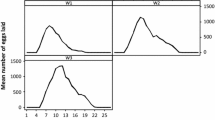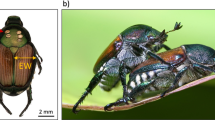Abstract
The process of oviposition in D. reticulatus was observed and found to be a sequence of exactly coordinated, interlocking events independent of the phase of oviposition. The average period of oviposition in the investigated ticks was 31.6 days at 20 °C and 95% relative humidity. The number of eggs deposited on each day increased until reaching a maximum on the fifth day of oviposition and then decreased continuously. As a result, most of the eggs were deposited during the initial phase of oviposition. The total number of eggs was proportional to the ticks' weight replenishment. Egg-laying commenced with the lowering of the capitulum and the simultaneous spread of the pedipalps which were lowered to the body wall embracing the genital aperture on both sides. Immediately afterwards the cuticular sac of Gene's organ was pushed out and retracted several times. At the cuticular sac's maximum extension, the vestibulum vaginae prolapsed, forming the ovipositor as an extended tube which handed over an egg to the two horns of the cuticular sac after a brief, but intensive, contact with the cuticular sac. Then the vestibulum vaginae invaginated, the pedipalps closed, and the cuticular sac was retracted. Finally, the egg was transported onto the dorsal area of the tick by means of a vigorous rising of the capitulum. During the course of oviposition most of the events, especially the period of egg embracement by the cuticular sac, were prolonged, as was the total time for laying one egg. Similarly, the intervals between successive egg-laying processes increased continuously.
The number of eggs deposited was not dependent on the functional ability of Gene's organ, as shown by similar numbers of deposited eggs from ticks with and without mechanical blocking of the cuticular sac. But the participation of the organ in the process of oviposition proved to be a prerequisite for the viability of the eggs. Larvae developed and hatched only from those eggs which were deposited from ticks with an undisturbed Gene's organ. In comparison, eggs without contact to the cuticular sac of Gene's organ dried up and shrivelled immediately after being deposited and did not hatch. Consequently, it strongly suggests, together with the results from other studies, that Gene's organ covers the eggs with a secretion that prevents the loss of water.
Similar content being viewed by others
References
Atkinson, P.W. and Binnington, K.C. 1973. New evidence on the function of the porose areas of ixodid ticks. Experientia 29, 799–800.
Booth, T.F., Beadle, D.J. and Hart, R.J. 1984. The ultrastructure of Gene's organ in the cattle tick Boophilus microplus CANESTRINI. Acarology 6, 261–267.
Feldman-Musham, B. 1963. Functions of the areae porosae of ixodid ticks. Nature 197, 100.
Gold, Y. 1983. Zur Entwicklung, Reproduktion und subspezifischen Validität von Rhipicephalus evertsi mimeticus Dönitz, 1910, sowie zur Paralyse-induzierenden Kapazit¨at der weiblichen Imagines. Inaug. Diss., Giessen, 343 pp.
Gothe, R., Göbel, E. and Neitz, A.W.H. 1987. Histology and ultrastructure of the glands associated with the porose areas on the gnathosoma of Rhipicephalus evertsi evertsi before and during oviposition. Exp. Appl. Acarol. 3, 255–265.
Gothe, R. and Nadler, G. 1986. Zur funktionellen Bedeutung der Areae porosae weiblicher Rhipicephalus evertsi evertsi NEUMANN, 1897. Dtsch. Tieraerztl. Wochenschr. 93, 390–393.
Gothe, R. and Nadler, G. 1987. Zur Mechanik der Oviposition bei Rhipicephalus evertsi evertsi NEUMANN, 1897. Berl. Muench. Tieraerztl. Wochenschr. 100, 109–113.
Kakuda, H., Mori T. and Shiraishi, S. 1992. Functional morphology of Gene's organ in Haemaphysalis longicornis (Acari: Ixodidae). Exp. Appl. Acarol. 16, 263–275.
Lees, A.D. and Beament, J.W.L. 1948. An egg-waxing organ in ticks. Q.J. Microsc. Sci. 89, 291–332.
McCamish, M., Cannell, G.R. and Cherry, L.M. 1977. The nonpolar egg wax lipids of the cattle tick, Boophilus microplus (Canestrini). Lipids 12, 182–187.
Sonenshine, D.E. 1991. Life cycles of ticks. In: Biology of ticks. Vol 1. D.E. Sonenshine (ed.) pp. 51–66 Oxford University Press.
Vermeulen, N.M.J., Gothe, R., Senekal, A.C. and Neitz, A.W.H. 1986. Investigations into the function and chemical composition of the porose areas secretion of Rhipicephalus evertsi evertsi during oviposition. Onderstepoort J. Vet. Res. 53, 147–152.
Zahler, M. 1994. Zur Ökologie von Dermacentor reticulatus (Fabricius, 1794) (Parasitiformes: Ixodoidea: Ixodidae). Inaug. Diss., Ludwig-Maximilians-University, Munich.
Zahler, M. and Gothe, R. 1995. Effect of temperature and humidity on longevity of unfed adults and on oviposition of engorged females of Dermacentor reticulatus (Ixodidae). Appl. Parasitol. 36, 200–211.
Zahler, M. and Gothe, R. 1997. Endemisierungsrisiko von Babesia canis durch Dermacentor reticulatus in Deutschland. Tieraerztl. Prax. 25, 666–670.
Author information
Authors and Affiliations
Rights and permissions
About this article
Cite this article
Sieberz, J., Gothe, R. Modus operandi of oviposition in Dermacentor reticulatus (Acari: Ixodidae). Exp Appl Acarol 24, 63–76 (2000). https://doi.org/10.1023/A:1006351019078
Issue Date:
DOI: https://doi.org/10.1023/A:1006351019078




